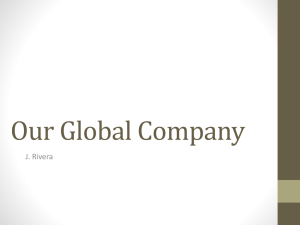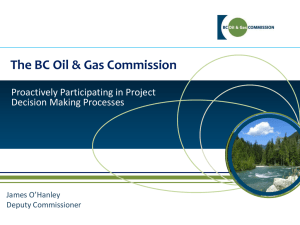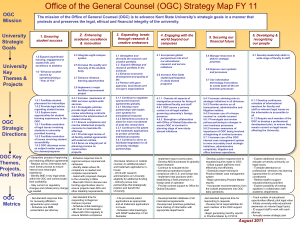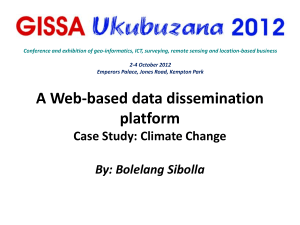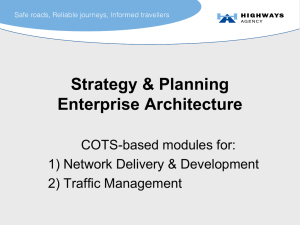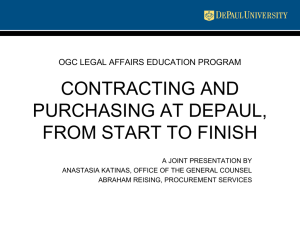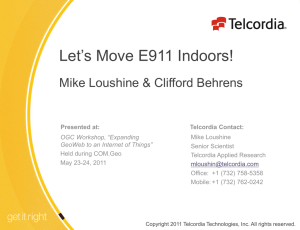The OGC and the Simple Features for SQL standard
advertisement
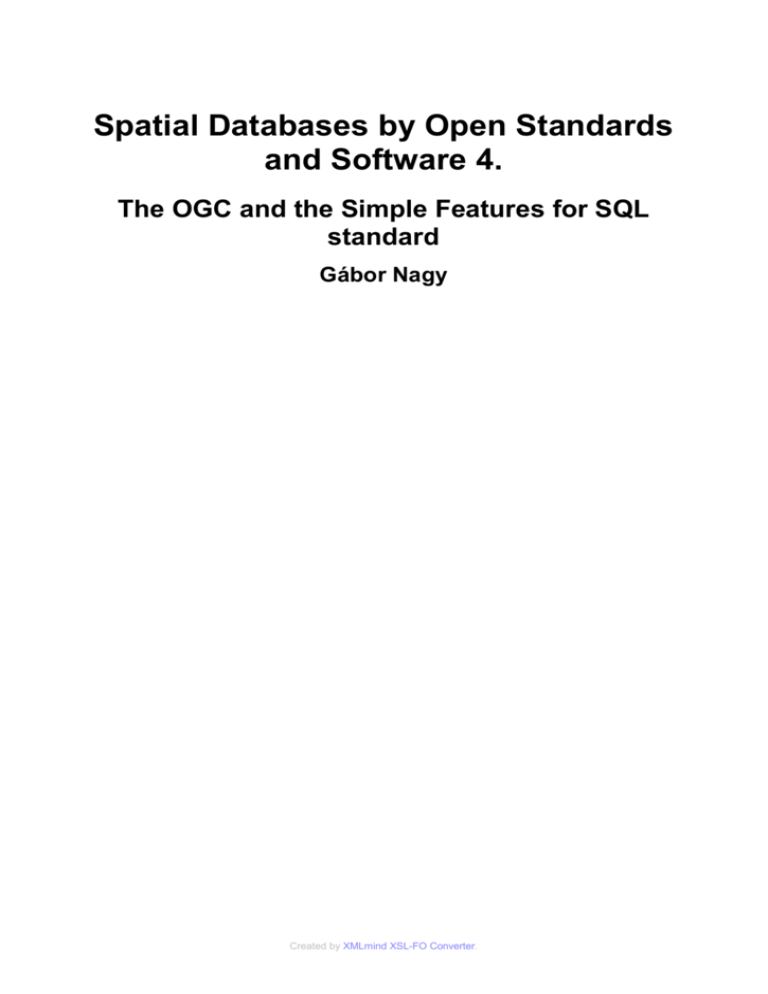
Spatial Databases by Open Standards and Software 4. The OGC and the Simple Features for SQL standard Gábor Nagy Created by XMLmind XSL-FO Converter. Spatial Databases by Open Standards and Software 4.: The OGC and the Simple Features for SQL standard Gábor Nagy Lector: Zoltán Siki This module was created within TÁMOP - 4.1.2-08/1/A-2009-0027 "Tananyagfejlesztéssel a GEO-ért" ("Educational material development for GEO") project. The project was funded by the European Union and the Hungarian Government to the amount of HUF 44,706,488. v 1.0 Publication date 2010 Copyright © 2010 University of West Hungary Faculty of Geoinformatics Abstract The Open Geospatial Consortium and the OGC standards, notably the Simple feature access standards (OGC 06-103r4, OGC 06-104r4). The right to this intellectual property is protected by the 1999/LXXVI copyright law. Any unauthorized use of this material is prohibited. No part of this product may be reproduced or transmitted in any form or by any means, electronic or mechanical, including photocopying, recording, or by any information storage and retrieval system without express written permission from the author/publisher. Created by XMLmind XSL-FO Converter. Table of Contents 4. The OGC and the Simple Features for SQL standard ..................................................................... 1. 4.1 Introduction ..................................................................................................................... 2. 4.2 Geometry objects ............................................................................................................ 2.1. 4.2.1 0-dimensional objects ...................................................................................... 2.2. 4.2.2 1-dimensional objects ...................................................................................... 2.3. 4.2.3 2-dimensional objects ...................................................................................... 2.4. 4.2.4 GeometryCollection ......................................................................................... 2.5. 4.2.5 Other objects .................................................................................................... 2.6. 4.2.6 Primitive or complex ....................................................................................... 2.7. 4.2.7 The validity of an object .................................................................................. 2.8. 4.2.8 The equality of two objects .............................................................................. 3. 4.3 Spatial methods ............................................................................................................... 3.1. 4.3.1 The DE-9IM .................................................................................................... 4. 4.4 Other OGC standards ...................................................................................................... iii Created by XMLmind XSL-FO Converter. 1 1 1 1 2 2 3 3 4 5 5 5 6 7 List of Tables 1. Objects with different classes ......................................................................................................... 4 2. The patterns of some named spatial relationships .......................................................................... 6 iv Created by XMLmind XSL-FO Converter. Chapter 4. The OGC and the Simple Features for SQL standard 1. 4.1 Introduction We introduce in this module the Open Geospatial Consortium (OGC) and two important standards of OGC: the 06-103r4 (OpenGIS Implementation Standard for Geographic information - Simple feature access - Part 1: Common architecture) and 06-104r4 (OpenGIS Implementation Standard for Geographic information - Simple feature access - Part 2: SQL option) standards. “The Open Geospatial Consortium is an international industry consortium of more than 400 companies, government agencies and universities participating in a consensus process to develop publicly available interface standards. OGC Standards support interoperable solutions that "geo-enable" the Web, wireless and location-based services and mainstream IT. The standards empower technology developers to make complex spatial information and services accessible and useful with all kinds of applications. “ (http://www.opengeospatial.org/) 2. 4.2 Geometry objects The OGC 06-103r4 (OpenGIS Implementation Standard for Geographic information - Simple feature access Part 1: Common architecture) establishes a common architecture and defines terms for other OGC standards. Within this framework the types of geometry objects and the methods of these objects are determined, and a textual and a binary format is defined to describe the geometry of objects. The WKT (Well-Known Text) is a textual description for the geometry of an object. This text begins the upper case name of the object type, and continues with a comma separated, multilevel point list within parentheses. The WKB (Well-Known Binary) is a binary description of geometry. This format requires less space in memory, and is typically processed faster, but is not human-readable. The geometries of the objects are described by points. These points are determined by two (XY, twodimensional), three (XYZ, three dimensional or XYM, two-dimensional measured) or four (XYZM, threedimensional measured) coordinates. The extra coordinate (M) is the measured range. (For example the stations in the roads.) A geometry primitive represents a single, connected, homogeneous element in space. A geometry complex can be a set of geometric primitives. 2.1. 4.2.1 0-dimensional objects The Point object is one simple point. (This is a geometric primitive.) The MultiPoint object may consist of more points. (This is a geometric complex.) 1 Created by XMLmind XSL-FO Converter. The OGC and the Simple Features for SQL standard Figure 1.: 0-dimensional objects The coordinates consist of two (XY) or three (XYZ) space-separated numbers in the WTK. The point list of the MultiPoint is separated by a comma. 2.2. 4.2.2 1-dimensional objects The LineString objects are defined by a sequence of points. The geometry of the LineString is built by line segments between the points of this sequence. (LineString is a geometric primitive.) Figure 2.: 1-dimensional objects The MultiLineString objects may consist of more linestrings. (This is a geometric complex) These linestrings may be separated or linked to each other. 2.3. 4.2.3 2-dimensional objects The Polygon object has one or more linear rings. The linear ring is a point sequence, having the same first and last point. These points determine a ring from linear segments. The first ring of the polygon is the external boundary, the other rings (if exist) are the internal boundaries of the object. (The Polygon is a geometric primitive, because it is a connected homogeneous set of the points, independent of the number of internal rings.) 2 Created by XMLmind XSL-FO Converter. The OGC and the Simple Features for SQL standard Figure 3.: 2-dimensional objects The MultiPolygon object has one or more external rings. Each external ring may have internal rings, which are located within the external ring. The MultiPolygon object is determined by a 3 level point list. (The MultiPolygon is a geometric complex.) 2.4. 4.2.4 GeometryCollection The GeometryCollection objects may consist of more simple sub-objects (Point, LineString, Polygon), which may have different dimensions. (This is a geometric complex.) The WKT string of the GeometryCollection has a comma separated list of the sub-objects. Figure 4.: GeometryCollection object 2.5. 4.2.5 Other objects The OGC 06-104r4 determines more other object classes to represent the geometry, but they are not discussed here in detail. The standard defines the ”Curve” superclass, but now this class contains only the LineString class. The following standard versions may introduce new types of Curve classes. The Polygon class is a subclass of ”Surface” class. The Surface superclass has two other subclasses: The TIN is built of triangles (3 point determined), the PolyhedralSurface is built of polygon (n point determined) surface elements. These objects are typically used for 3D meshes. 3 Created by XMLmind XSL-FO Converter. The OGC and the Simple Features for SQL standard Figure 5.: The class diagram of the classes of the OGC 06-103r4 (Figure 1 from the standard) 2.6. 4.2.6 Primitive or complex Every learned geometric primitive (for example: POINT(4 3) ) can be presented by a geometric complex (MULTIPOINT(4 3)), and every other learned class can be described by a GeometryCollection (GEOMETRYCOLLECTION(POINT(4 3))). This table contains examples for representing an object by different classes: Table 1. Objects with different classes geometric primitive geometric complex GeometryCollection POINT(7 5) MULTIPOINT(7 5) GEOMETRYCOLLECTION( POINT(7 5)) n/a MULTIPOINT(5 6,8 4) GEOMETRYCOLLECTION( POINT(5 6), POINT(8 4)) LINESTRING(1 6,4 7,7 5,8 3,11 5) MULTILINESTRING((1 GEOMETRYCOLLECTION( 6,4 7,7 5,8 3,11 5)) LINESTRING(1 6,4 7, 7 5, 8 3,11 5)) n/a MULTILINESTRING((1 GEOMETRYCOLLECTION( 5,5 6,7 5,12 6),(4 3,7 2,9 3)) LINESTRING(1 5,5 6,7 5,12 6),LINESTRING(4 3,7 2,9 3)) POLYGON((2 7,5 8,10 7,11 3,7 1,3 3,2 7),(6 6,9 5,9 3,6 6)) MULTIPOLYGON(((2 7,5 8,10 7,11 3,7 1,3 3,2 7),(6 6,9 5,9 3,6 6))) GEOMETRYCOLLECTION( POLYGON((2 7,5 8,10 7,11 3,7 1,3 3,2 7),(6 4 Created by XMLmind XSL-FO Converter. The OGC and the Simple Features for SQL standard 6,9 5,9 3,6 6))) n/a n/a MULTIPOLYGON(((2 2,1 9,8 7,9 1,2 2),(3 6,5 5,6 3,4 3,3 6)),((10 6,13 4,11 1,10 6))) GEOMETRYCOLLECTION( n/a GEOMETRYCOLLECTION( POLYGON((2 2,1 9,8 7,9 1,2 2),(3 6,5 5,6 3,4 3,3 6)), POLYGON((10 6,13 4,11 1,10 6))) LINESTRING(2 9,4 7), POLYGON((4 7,5 7,9 5, 7 3,4 6,4 7)), LINESTRING(8 4,10 2, 13 1)) When we choose the class of the objects (the type of a column of a table), we have to advert that primitive objects can be represented as complex objects, but it is not true conversely. 2.7. 4.2.7 The validity of an object The Polygon (and MultiPolygon) geometry has some constraints: • the linear rings of the polygon are closed (same start and end point) • the linear rings of the polygon do not cross themselves or other linear rings The geometry is valid, if these constraints are satisfied. 2.8. 4.2.8 The equality of two objects There are several ways to describe the same object, for the following reasons: • the order of the elements of a complex object is indifferent (MultiPoint, MultiLineString, MultiPolygon, GeometryCollection) • the start (and end) point of a linear ring is indifferent • the direction of the linear rings is indifferent • the order of the inner rings of a polygon is indifferent The equality test operations have to take into consideration the above mentioned. 3. 4.3 Spatial methods The OGC 06-103r4 determines methods for the geometry objects. These methods (functions) are the tools of the spatial analysis in the implementation of the standards. The standard uses an object-oriented model. The methods of the superclasses are usable in the subclasses. 5 Created by XMLmind XSL-FO Converter. The OGC and the Simple Features for SQL standard Figure 6.: The Geometry class of the OGC 06-103r4 (Figure 2 from the standard) The ”Geometry” is a top level superclass. The methods of this class are available in each class. 3.1. 4.3.1 The DE-9IM The spatial relations between two geometric objects are defined by the dimensional extended nine-intersection model (DE-9IM). This is a 3x3 matrix, which contains nine numbers, the dimension of intersection set of the interior, boundary and exterior of the two objects. The interior is the set of all direct positions (the standard uses this term, because the ”Point” is an object class) that are inside a geometric object, but which are not on its boundary. The boundary is the set that represents the limit of an entity. The exterior is the difference between the universe and the closure. In the 2D plane, the numbers of the DE-9IM are 0, 1 or 2, if a common part of the two sets exists. The number is -1, when the sets do not have any common points. This case is marked ”F” letter too, because the DE-9IM should be stored in a nine-character long string (the “-1” is two letters). The DE-9IM is calculated from two arbitrary objects. The named spatial relationship methods (contains, intersects, crosses, touches, etc.) can be defined by one or more DE-9IM pattern. The patterns are nine character long strings, which contain ”T”, “F”, “*”, “0”, “1” and “2” letters. The “*” means: any value, the “T” means: “0”, “1” or “2” value. Table 2. The patterns of some named spatial relationships relationship pattern(s) (the elements of DE-9IM, left to right 6 Created by XMLmind XSL-FO Converter. The OGC and the Simple Features for SQL standard and up to down) equals TFFFTFFFT disjoint FF*FF**** touches FT******* F**T***** F***T**** crosses T*T****** 0******** within T*F**F*** overlaps T*T***T** 1*T***T** contains T*****FF* intersects T******** 4. 4.4 Other OGC standards The Open Geospatial Consortium has more important standards. The Simple Feature Access family has two more members for the CORBA (OGC 99-054) and the OLE/COM (OGC 99-050) environment. The OpenGIS Geography Markup Language Encoding Standard (GML, OGC 07-036) specifies the GML. GML is an XML grammar for expressing geographical features. “GML serves as a modelling language for geographic systems as well as an open interchange format for geographic transactions on the Internet. As with most XML based grammars, there are two parts to the grammar – the schema that describes the document and the instance document that contains the actual data. A GML document is described using a GML Schema. This allows users and developers to describe generic geographic data sets that contain points, lines and polygons. However, the developers of GML envision communities working to define community-specific application schemas that are specialized extensions of GML. Using application schemas, users can refer to roads, highways, and bridges instead of points, lines and polygons. If everyone in a community agrees to use the same schemas they can exchange data easily and be sure that a road is still a road when they view it. Clients and servers with interfaces that implement the OpenGIS Web Feature Service Interface Standard read and write GML data. GML is also an ISO standard (ISO 19136:2007)” (http://www.opengeospatial.org/standards/gml) “The OpenGIS Web Map Service Interface Standard (WMS, OGC 06-042) provides a simple HTTP interface for requesting geo-registered map images from one or more distributed geospatial databases. A WMS request defines the geographic layer(s) and area of interest to be processed. The response to the request is one or more geo-registered map images (returned as JPEG, PNG, etc.) that can be displayed in a browser application. The interface also supports the ability to specify whether the returned images should be transparent so that layers from multiple servers can be combined or not.” (http://www.opengeospatial.org/standards/wms) “The Web Feature Service (WFS, OGC 09-025r1) represents a change in the way geographic information is created, modified and exchanged on the Internet. Rather than sharing geographic information at the file level using File Transfer 7 Created by XMLmind XSL-FO Converter. The OGC and the Simple Features for SQL standard Protocol (FTP), for example, the WFS offers direct fine-grained access to geographic information at the feature and feature property level. Web feature services allow clients only to retrieve or modify the data they are seeking, rather than retrieving a file that contains the data they are seeking and possibly much more. That data can then be used for a wide variety of purposes, including purposes other than their producers' intended ones.” (Introduction of OGC 09-025r1) “KML is an XML language focused on geographic visualization, including annotation of maps and images. Geographic visualization includes not only the presentation of graphical data on the globe, but also the control of the user's navigation in the sense of where to go and where to look.” (http://www.opengeospatial.org/standards/kml) “The KML was developed by the Google. This XML based language is used in the GoogleEarth and the GoogleMaps solutions. Now, the OGC and the Google work together on the KML standard.” Bibliography: Open Geospatial Consortium: OpenGIS Implementation Standard for Geographic information - Simple feature access - Part 1: Common architecture, 2010 Open Geospatial Consortium: OpenGIS Implementation Standard for Geographic information - Simple feature access - Part 2: SQL option, 2010 Open Geospatial Consortium: OpenGIS Geography Markup Language (GML) Encoding Standard, 2007 Open Geospatial Consortium: OpenGIS Web Map Server Implementation Specification, 2006 Open Geospatial Consortium: OpenGIS Web Feature Service 2.0 Interface Standard, 2010 8 Created by XMLmind XSL-FO Converter.
